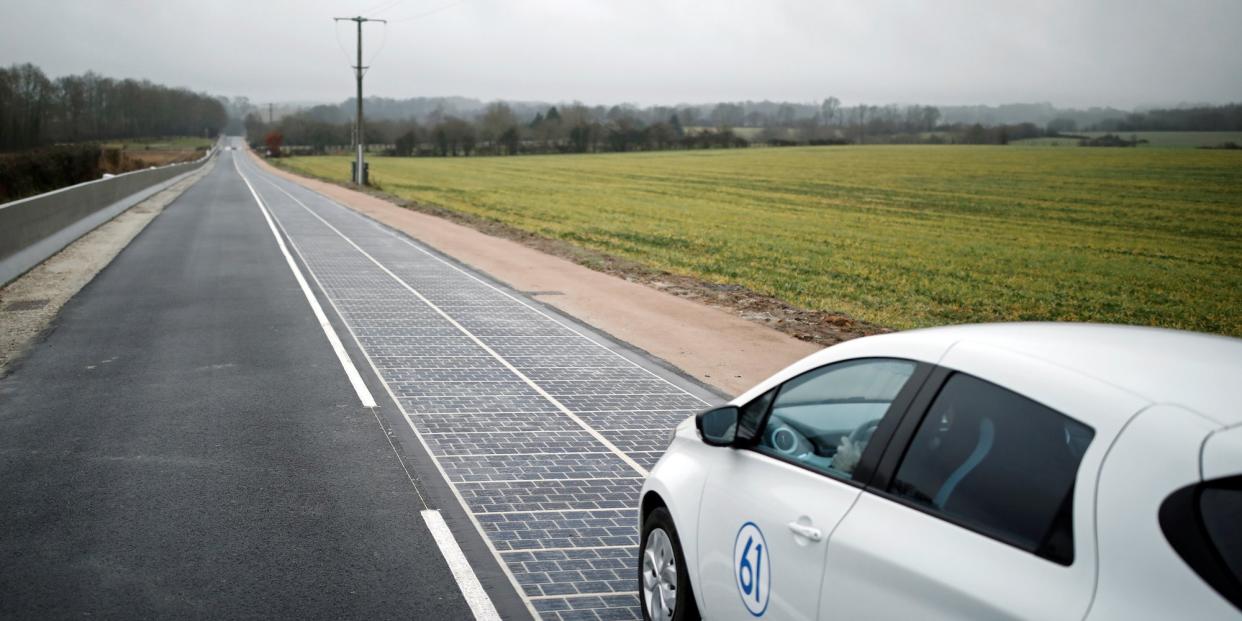Photos show the world's first solar road that's turned out to be a colossal failure because it's falling apart and doesn't generate enough energy

In July, a French daily newspaper published a story saying the longest solar road in the world had failed. It's neither economically viable or energy efficient.
Less than three years since the road opened, it's become cracked and damaged. Parts of the road have been demolished because they weren't salvageable.
Energy targets were never hit, because engineers didn't plan for rotting leaves to block sunlight. These photos show how
France appears to have been on the solar road to nowhere.
In July, the French daily newspaper Le Monde reported that the 0.6-mile solar road was a fiasco.
In December 2016, when the trial road was unveiled, the French Ministry of the Environment called it "unprecedented." French officials said the road, made of photovoltaic panels, would generate electricity to power streetlights in Tourouvre, a local town.
But less than three years later, a report published by Global Construction Review says France's road dream may be over. Cracks have appeared, and in 2018, part of the road had to be demolished due to damage from wear and tear.
Even at its peak, the road was only producing half of the expected energy, because engineers didn't take into consideration rotting leaves falling on the road.
Here what the road looked like in all of its former glory, and how it got to this point.
It was all smiles and high hopes in 2016, when the world's first solar panel road, called Wattway, opened. France spent $5.2 million on 0.6 miles of road, and 30,000 square feet of solar panels. It was hailed as the longest solar road in the world.

Benoit Tessier / Reuters
Source: The Verge
Media gathered around to take a walk down what was thought to be the road of the future. The French minister for energy said she wanted to have solar panels on one mile of road every 621 miles in the country within the next five years.

Benoit Tessier / Reuters
Source: NBC
Despite grey skies on the day of the inauguration, France was leading the world for solar transportation.

Benoit Tessier / Reuters
But the brake was never removed, and the wheels never started rolling — so to speak.

Benoit Tessier / Reuters
It was a bold move beginning a solar panel trial in Normandy, France, since the region doesn't have the most sunshine. Caen, a city in Normandy, only has 44 days of strong sunshine in a year. Thunderstorms also reportedly broke solar panels on the road.

Wikimedia
Sources: Le Monde, The Guardian
The trial road was meant to produce about 150,000 kWh a year, which is enough power to provide light for up to 5,000 people, every day. Instead, it was making just under 80,000 in 2018, and fewer than 40,000 by July 2019.

Benoit Tessier / Reuters
Sources: Business Insider, Le Monde
Colas, the company that built the road, said in 2016 that the solar panels were covered with resin containing sheets of silicon to make them capable of withstanding all traffic. But since the opening, panels have come loose or broken into little pieces.

Benoit Tessier / Reuters
Source: Business Insider, The Guardian
In May 2018, 300 feet of the road had to be demolished since it wasn't salvageable.

Fabrizio Bensch / Reuters
The engineers also didn't take into account the effects of leaves, which caused damage and limited the amount of electricity the panels could produce. They also didn't think about the pressure and weight from tractors, two locals told Le Monde.

Stephane Mahe / Reuters
Sources: Le Monde, Global Construction Review
And now the trial looks like it's all over. Wattway's managing director Etienne Gaudin told Le Monde that it would not be going to market. "Our system is not mature on long distance traffic," he said. The company would focus on creating electricity for smaller things, like CCTV cameras and lighting bus shelters.

Benoit Tessier / Reuters
Source: Global Construction Review

